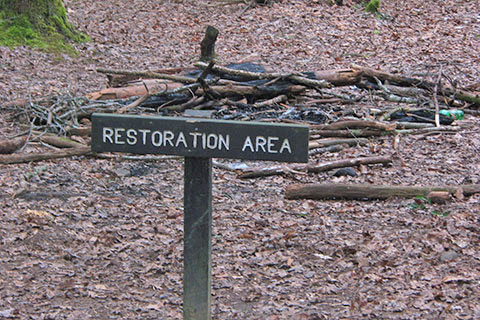| 883 | Minimum Impact Usage Actions |
2013-11-15 |

Humans used to belong in the wilderness just as the deer, raccoon, bear, etc - also belong. But, through the years, humans have slowly changed their habitats to distance themselves from living outdoors. When primitive humans lived in the wilderness, they practiced minimum impact usage out of necessity. They understood their environment. To survive, they had to learn to leave minimal impact so that other humans or animals were not able to track them. They lived a minimum impact lifestyle. They could travel without turning a branch or leaving a footprint. Through the years, humans distanced themselves from the wilderness. Instead of living off the land, the land became a resource and humans evolved into visitors.
Now as we accept our visitor status on trips to the wilderness, the conditions for our visit are very similar to our visiting someone's home - we show respect, are gracious, avoid doing any damage, and follow the house rules (see links below for these previously discussed topics). These rules for visiting someone's home are part of our unwritten laws of conduct, but similar rules should also be a part of our visits to the wilderness lands. To be more than just a visitor, we need to practice minimum impact usage. We need to move from the innate rules of being a visitor into actions.
Over the next weeks we will continue our series as we discuss the actions for minimum impact usage. To help us adapt minimum impact usage as a natural part of our lives we need to:
1) Increase knowledge of the environment and how our presence effects it
2) Practice trip organization skills to lessen our impact
3) Learn to give back by volunteering for trail work or other types of services that help establish personal ownership
4) Practice awareness, assessment, and prevention
5) Become an evangelist for low impact usage.
As we learn to practice minimum impact usage we will find ways to grow closer to the land, but it takes action.
Happy Minimum Impact Actions trails
Minimum Impact Usage - Wilderness Responsibility
Minimum Impact Usage - Wilderness Responsibility - Respect
Minimum Impact Usage - Wilderness Responsibility - Gracious
Minimum Impact Usage - Wilderness Responsibility - Avoiding Damage
Minimum Impact Usage - Wilderness Responsibility - House Rules
Minimum Impact Usage - Actions
Minimum Impact Usage - Actions - Knowledge
Minimum Impact Usage - Actions - Planning
Minimum Impact Usage - Actions - Giving Back
Minimum Impact Usage - Actions - Awareness and Prevention
Other links
Wilderness Education Association